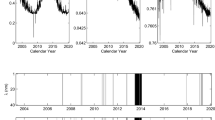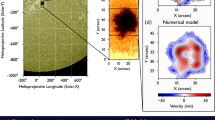Abstract
The temporal behaviour of solar activity (as manifested in sunspots) has long been debated. The 11-year periodicity in the total number of sunspots is well established observationally, as is a periodicity of 152–158 days in the occurrence of high-energy solar flares that was seen during cycle 21 (1–7). The cause of the latter periodicity is not clear, although several mechanisms have been proposed8,9,10. Here we report a time–frequency analysis, using the wavelet technique, of sunspot areas between 1874 and 1993, which reveals a 158-day periodicity coincident with that of energetic solar flares. The signature of this periodicity is strongest in cycle 19, which was the most intense cycle of the century. The periodicity disappears after cycle 21. The analysis shows that the 158-day periodicity in both high-energy solar flares and sunspots is related to a periodic emergence of magnetic flux which only appears near the maxima of some solar cycles.
This is a preview of subscription content, access via your institution
Access options
Subscribe to this journal
Receive 51 print issues and online access
$199.00 per year
only $3.90 per issue
Buy this article
- Purchase on Springer Link
- Instant access to full article PDF
Prices may be subject to local taxes which are calculated during checkout

Similar content being viewed by others
References
Rieger, E. et al. A154-day periodicity in the occurrence of hard solar flares? Nature 312, 623–625 (1984).
Dennis, B. R. Solar hard X-ray bursts. Sol. Phys. 100, 465–490 (1985).
Bogart, R. S. & Bai, T. Confirmation of a 152 day periodicity in the occurrence of solar flares inferred from microwave data. Astrophys. J. 299, L51–L55 (1985).
Bai, T. & Cliver, E. W. A154 day periodicity in the occurrence rate of proton flares. Astrophys. J. 363, 299–309 (1990).
Dröge, W. et al. A153 day periodicity in the occurrence of solar flares producing energetic interplanetary electrons. Astrophys. J. Suppl. Ser. 73, 279–283 (1990).
Kile, J. N. & Cliver, E. W. Asearch for the 154 day periodicity in the occurrence rate of solar flares using Ottawa 2.8 GHz burst data. 1955–1990. Astrophys. J. 370, 442–448 (1991).
Verma, V. K., Joshi, G. C. & Paliwal, D. C. Study of periodicities of solar nuclear gamma ray flares and sunspots. Sol. Phys. 138, 205–208 (1992).
Bai, T. & Sturrock, P. A. The 154-day and related periodicities of solar activity as subharmonics of a fundamental period. Nature 350, 141–142 (1991).
Sturrock, P. A. & Bai, T. Search for evidence of a clock related to the solar 154 day complex of periodicities. Astrophys. J. 397, 337–346 (1992).
Bai, T. & Sturrock, P. A. Evidence for a fundamental period of the Sun and its relation to the 154 day complex of periodicities. Astrophys. J. 409, 476–486 (1993).
Forbes, T. G. Magnetic reconnection in solar flares. Geophys. Astrophys. Fluid Dyn. 62, 15–36 (1991).
Priest, E. R. in Basic Plasma Processes on the Sun (eds Priest, E. R. & Krishnan, V.) 271–291 (Kluwer Academic, Dordrecht, (1990)).
Carbonell, M. & Ballester, J. L. Ashort-term periodicity near 155 day in sunspot areas. Astron. Astrophys. 238, 377–381 (1990).
Canfield, R. C. et al. in X-Ray Solar Physics From Yohkoh (eds Uchida, Y., Watanabe, T., Shibata, K. & Hudson, H. S.) 153–156 (Universal Academy, Tokyo, (1993)).
Rabin, D. M., DeVore, C. R., Sheeley, N. R., Harvey, K. L. & Hoeksema, J. T. in Solar Interior and Atmosphere (eds Cox, A. C., Livingston, W. C. & Matthews, M. S.) 781–843 (Univ. Arizona Press, Tucson, (1991)).
Bai, T. Distribution of flares on the Sun: Superactive regions and active zones of 1980–1985. Astrophys. J. 314, 795–807 (1987).
Lean, J. L. & Brueckner, G. E. Intermediate-term solar periodicities: 100–500 days. Astrophys. J. 337, 568–578 (1989).
Lean, J. L. Evolution of the 155 day periodicity in sunspot areas during solar cycles 12 to 21. Astrophys. J. 363, 718–727 (1990).
Carbonell, M. & Ballester, J. L. The periodic behaviour of solar activity: the near 155 day periodicity in sunspot areas. Astron. Astrophys. 255, 350–362 (1992).
Bai, T. The 77 day periodicity in the flare rate of cycle 22. Astrophys. J. 388, L69–L72 (1992).
Oliver, R. & Ballester, J. L. Short-term periodicities in sunspot areas during solar cycle 22. Sol. Phys. 156, 145–155 (1990).
Grossmann, A. & Morlet, J. Decomposition of Hardy functions into square integrable wavelets of constant shape. SIAM J. Math. Anal. 15, 723–736 (1984).
Bracewell, R. N. The Fourier Transform and its Applications 160 (McGraw-Hill, New York, (1978).
Author information
Authors and Affiliations
Corresponding author
Rights and permissions
About this article
Cite this article
Oliver, R., Ballester, J. & Baudin, F. Emergence of magnetic flux on the Sun as the cause of a 158-day periodicity in sunspot areas. Nature 394, 552–553 (1998). https://doi.org/10.1038/29012
Received:
Accepted:
Issue Date:
DOI: https://doi.org/10.1038/29012
This article is cited by
-
Temporal and Periodic Analysis of Penumbra–Umbra Ratio for the Last Four Solar Cycles
Solar Physics (2024)
-
Hydrogen Lyman-Alpha Periodicity Behaviour During Various Solar Cycles
Astrophysics and Space Science (2023)
-
Variation of Chromospheric Features as a Function of Latitude and Time Using Ca-K Spectroheliograms for Solar Cycles 15 – 23: Implications for Meridional Flow
Solar Physics (2021)
-
Rieger Periodicity Behaviour in Solar Mg ii 280 nm Spectral Emission
Solar Physics (2021)
-
Investigation of the Hemispheric Asymmetry in Solar Flare Index During Solar Cycle 21 – 24 from the Kandilli Observatory
Solar Physics (2020)
Comments
By submitting a comment you agree to abide by our Terms and Community Guidelines. If you find something abusive or that does not comply with our terms or guidelines please flag it as inappropriate.



